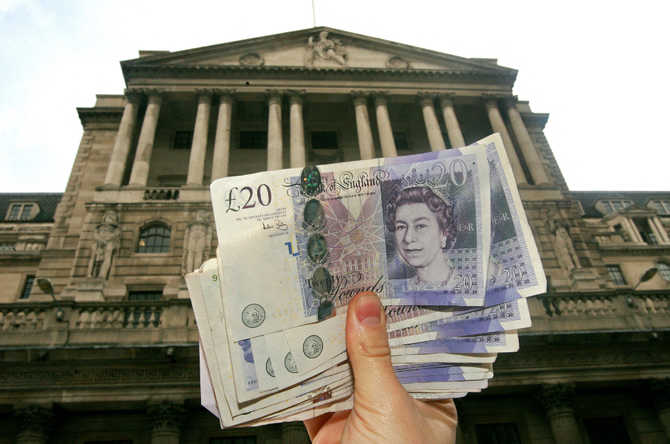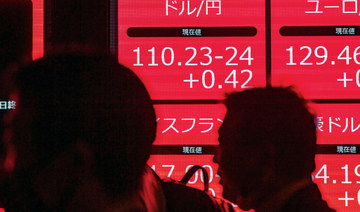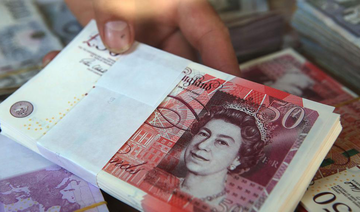LONDON: Sterling extended its fall against the US dollar on Friday, dropping below $1.39, hurt by the US Federal Reserve’s hawkish surprise and an unexpected fall in Britain’s retail sales.
The pound dropped against a strengthening dollar on Thursday after the Fed surprised markets by signaling it would raise interest rates and end emergency bond-buying sooner than expected.
On Friday, it fell further against both the dollar and the euro. It was down 0.3 percent on the day at $1.389, having touched as low as $1.38555 — its weakest since May 4. It was on track for its worst week since September 2020.
Versus the euro, it was down around 0.3 percent at 85.78 pence per euro, on track for a small weekly fall.
“GBPUSD remains bogged down below the 1.39 handle by a confluence of broad USD strength and a slight deterioration in near-term data,” said Simon Harvey, senior FX market analyst at Monex Europe.
“The limited impact of the data on sterling is largely because retail sales volumes remain above pre-pandemic levels and a shift in consumption patterns toward services after the May 17th reopening was always likely.”
For cable, market participants are weighing up the Bank of England and the Fed’s relative pace of possible monetary policy tightening. The BoE next meets on June 24.
BofA strategists said in a note to clients that it changed its view on the central bank’s tightening trajectory.
and now expects a 15 basis point rate hike in May 2022, compared to previously expecting no hikes in 2022.
“Brussels’ patience with London’s having its cake and eating it is wearing thin. Indeed, there is a risk of protocols being triggered and tariffs being threatened more seriously,” wrote ING strategists in a note to clients.
“The next few weeks could thus be a vulnerable period for Cable, where a break of 1.3890 opens up 1.3800/3810 — the last stop before an extension to the March/April lows of 1.3675.”
Sterling set for worst week since Sept. 2020
https://arab.news/nrr9w
Sterling set for worst week since Sept. 2020

Ukraine keen to cooperate with KSA in digitalization push: vice minister

- European nation’s growing prowess in technology could help Saudi Arabia in its digital transformation journey
RIYADH: Saudi Arabia’s technological landscape is set to get a boost as Ukraine has expressed its eagerness to cooperate with the Kingdom in multiple sectors including agri-tech, fintech, and cybersecurity.
Speaking to Arab News during his visit to the Saudi capital, Oleksandr Bornyakov, Ukraine’s vice minister of digital transformation, said the European nation’s growing prowess in technology could help Saudi Arabia in its digital transformation journey.
During his visit to the Kingdom, the vice minister held meetings with the officials of the Kingdom’s information and investment ministries and the General Authority of Small and Medium Enterprises also known as Monsha’at.
“My visit is kind of like exploring — breaking the ice. Since we are the policymaking body in Ukraine, we know everybody in Ukraine from the tech sector. We want to hear from the local government
about what kind of problems they face, and what kind of things they need, and then, decide what’s the best fit for fulfilling those. I think there’s an interest in bringing this expertise to Saudi Arabia,” said the vice minister.
He added: “From an educational perspective we build a framework of how we teach people from school to university. So they become very talented engineers. We have expertise in almost every sector like healthcare, automotive, energy, and finance. And when countries like Saudi Arabia, trying to digitize any of these fields, I think we could be helpful.”
He said that his visit to Riyadh seeks to establish a relationship on the government level, which will in turn help them to cooperate with private sector entities including startups in the future.
During his visit to the Kingdom, the Ukrainian vice minister also presented several digital products to Saudi officials that can be used on the government-to-government level.

The world is changing fast, and I can’t imagine my life without many digital things that I have become used to. So I think any country that wants to follow up on this and, be on the edge of the technology has to change and invest a lot in this.
Oleksandr Bornyakov, Ukraine’s vice minister of digital transformation
He said that Saudi Arabia is quickly developing, and there is enormous potential for technological firms in the Kingdom.
Bornyakov added that Saudi Arabia should build an entrepreneurship culture in the Kingdom so that local talents in the country can leapfrog in the technological sector with innovations and products.
“The world is changing fast, and I can’t imagine my life without many digital things that I have become used to. So I think any country that wants to follow up on this and, be on the edge of the technology has to change and invest a lot in this. Because, in the West, many great things happen. Even Google, it came from students,” the official said.
He added: “I think, Gulf countries and Saudi Arabia in particular also want to have this, this entrepreneurship culture. And, we know how to teach people how to do that, and, be part of this. I think that’s why we have this mutual interest. And I feel that Saudi Arabia is open to that experience.” Bornyakov further noted that Saudi Arabia’s business-friendly environment for foreign investments is one of the main reasons behind his current tour of the Kingdom.

“Here, there is an investment environment. You can easily come to create a business in one or two days, then open a bank account, and then you are good to go. So this is one of the reasons that we decided to do this tour and, figure out who’s doing what,” he added.
The vice minister also lauded Saudi Arabia’s efforts to diversify its economy away from oil aligned with the goals outlined in Vision 2030.
“I think diversifying is a good idea. It’s actually what’s happening in Ukraine. When I started in 2019, the contribution of the IT sector to the gross domestic product was 2.5-2.6 percent, and now it is close to 5 percent. As of today, 41 percent of all Ukrainian export services are IT.
“I think it is also something interesting here. The energy sector might be strong, for how many years, we do not know,” he said.
According to Bornyakov, Ukraine is also steadily reducing its dependence on grains and heavy machinery, and technological products from the IT sector are becoming major contributors to the nation’s economy.
“Historically, Ukraine was what? Grain and heavy machinery. Unfortunately, due to war, we lost a lot of factories and heavy machinery. And because we thought about IT, even though, less than a decade ago, but still, the sector was evolving very fast. We now have a source of export revenue, which is almost $8 billion every year, and just maybe five years ago, it was $3 billion or $4 billion,” he added.
HIGHLIGHT
Oleksandr Bornyakov’s visit to Riyadh seeks to establish a relationship on the government level, which will in turn help them to cooperate with private sector entities including startups in the future.
Bornyakov also talked about the success of Ukraine’s Diaa application which allows Ukrainians to use digital documents on their smartphones instead of physical ones for identification and sharing purposes, along with accessing over 130 government services.
According to the vice minister, there are 20 million active Diaa users in Ukraine, and he claimed that no other government app in the world can boast about such a huge user database. He also added that such applications have huge potential in the Gulf Cooperation Council region, which will reduce the hassles of paper passports and other government documents, as it allows people to carry everything on a smartphone.
“We want to implement the vision of President Zelensky to build a country in smartphone. Then we created a government super app called Diaa. We started by putting all the papers of a citizen like driver’s license, car titles, insurance, diplomas, birth certificates, tax IDs, and passport, everything on the phone, so you don’t carry paper. So, we were the first country in the world to introduce digital passports,” said Bornyakov.
He added: “There is a huge demand for such apps since Gulf countries have a union, GCC. And if you travel, and if you want to identify yourself, you will have to use different passports and different procedures. We have a solution to solve all of these problems.”
According to the vice minister, Ukraine has opened a source code for these applications, which makes countries use these codes to develop applications as per their requirements.
“Recently, we have opened source code, so you don’t have to pay us. So you can take this and we can showcase and you can use the source code to build, something that you own as this union (GCC), and use it for the sake of its people. And that is one of the things we are happy to share with the world,” he added.
Saudi Arabia’s fintech sector driving digital transformation

- More than $1 billion has been invested in local fintech firms, says report
CAIRO: Saudi Arabia’s fintech sector has made significant strides as it nears its goal to become a regional financial hub, according to a report by Arthur D. Little.
In its latest study titled “Realizing Potential of Fintech in Kingdom of Saudi Arabia,” the international management consulting firm highlighted the rapid growth and innovation within the sector, spearheaded by initiatives such as Fintech Saudi.
Launched in April 2018 by the Saudi Central Bank, also known as SAMA, and the Saudi Capital Markets Authority, Fintech Saudi has been a pivotal force in promoting the Kingdom as the leading fintech hub in the Middle East and North Africa.
The initiative includes programs such as an accelerator, career fair, fintech tour, and summer sessions, contributing to a 20-fold increase in the number of fintech companies in the Kingdom since the program’s establishment.
To date, more than SR4 billion ($1 billion) has been invested in local fintech companies, with over 100,000 individuals participating in related events and training programs, the report said.
The adoption of a national strategy in May 2022 marked a significant advancement in the country’s fintech sector.
The strategy is built on six pillars, which include establishing the Kingdom as a regional fintech hub, fostering a regulatory environment conducive to growth, providing funding for startups, enhancing skills training, accelerating support infrastructure, and promoting local and international collaboration.
Ambitious goals
The Vision 2030 goals include the establishment of at least 525 fintech companies by 2030, up from 200 in 2023, the creation of 18,000 fintech job opportunities, up from approximately 5,400 in 2023, contribute SR13.3 billion to the gross domestic product, a substantial increase from around SR3.75 billion in 2023, and achieve SR12.2 billion in direct venture capital contributions, compared to SR5.2 billion in 2023.
Fintech Saudi has catalyzed this growth through various initiatives, including the Fintech Accelerator Program, the Fintech Saudi Innovation Hub, and an online Fintech directory.
Additionally, the establishment of a fintech regulatory sandbox by SAMA has allowed for controlled live testing of fintech innovations, easing their transition to the open market. Further boosting the sector, the Saudi Venture Capital Co., backed by CMA and the Financial Sector Development Program, has launched a SR300 million fund focused on fintech startups, with plans to invest an additional SR6 billion in startups and small and medium enterprises across various sectors.
So far, SVC investment in 35 VC funds has facilitated over 900 deals and SR1.9 billion in investments. Additionally, the Saudi National Technology Development Program has introduced the Technology Development Financing Initiative, providing debt funding to support startups.
A cashless society
“Saudi Arabia has embarked on a journey to transform society to be less dependent on cash transactions,” the report noted, highlighting the FSDP as instrumental in this shift by fostering a regulatory environment conducive to the growth of payment companies.
The ambition of Vision 2030 is notably high, aiming to increase the proportion of non-cash transactions to 80 percent by 2030, up from just 18 percent in 2016.
Remarkably, by 2021, cashless payments constituted 62 percent of all transactions, significantly surpassing the interim targets, the report stated.

Saudi Arabia has embarked on a journey to transform society to be less dependent on cash transactions.
Mohammad Nikkar, principal at Arthur D. Little
This rapid adoption has been supported by the integration of innovative payment solutions, including digital wallets, local transfers, QR code payments, and the SADAD system for bill payments.
“According to data released by SAMA, digital wallet usage has seen an exponential rise from 315,000 in 2018 to 17 million by 2022, representing over half of Saudi Arabia’s population,” the report stated.
Initially, bank transfers dominated as the primary method for topping up these wallets, but by 2022, around 80 percent of top-ups were being made via debit or credit cards, indicating a shift in consumer behavior.
The report also sheds light on the increasing reliance on digital wallets among expatriates for international transfers, with non-Saudi users of digital wallets increasing from 17 percent in 2018 to 45 percent in 2022.
Among the leaders in this burgeoning market are stc pay and urpay. stc pay, in particular, has distinguished itself as the first fintech unicorn in the Kingdom, with a notable 25 percent year-on-year increase in profits in 2022, as stated in the report.
Alternative financing
The report, co-authored by Mohammad Nikkar, principal at Arthur D. Little, and Arjun Vir Singh, partner at the firm, delved into Saudi Arabia’s alternative financing sector, notably buy now, pay later and debt crowdfunding, which has become the second-largest fintech subsector after Saudi Payments.
BNPL usage has surged from 76,000 customers in 2020 to over 10 million in 2022, with market leaders like Saudi-based Tabby
and Tamara expanding across the Gulf Cooperation Council, the report explained.
Debt crowdfunding is also growing as a vital funding source for SMEs. Since 2019, investors have issued over 1,800 loans worth more than SR1.1 billion, with SR770 million disbursed in 2022 alone.
However, challenges persist with rising interest rates and fluctuating approval rates.
Challenges
“While the future for fintech in Saudi Arabia looks bright, there are still some important challenges to overcome,” the report stated.
Increasing Saudi Arabia’s visibility on the international stage is crucial. The report emphasizes the need to enhance the Kingdom’s global profile by articulating its unique fintech ecosystem offerings to attract more global entrepreneurs and investors.
“Streamlining regulatory frameworks. Efforts to simplify the setup and licensing processes are underway to create a more navigable regulatory environment for fintech entities. Continued enhancements in this area will support both local and international ventures,” the report added.
Furthermore, expanding funding avenues is also essential. The development of more accessible financial mechanisms such as accelerators and grants is expected to invigorate the investment climate, allowing a diverse range of fintech initiatives to flourish, the report explained.
Addressing the talent gap is also a priority as strategies should be implemented to cultivate local expertise and address challenges like high turnover and competitive salary demands.
Moreover, optimizing investment in infrastructure to reduce the cost of essential technology, while ensuring compliance with local data regulations, is also a vital aspect.
Lastly, fostering international partnerships is key to the long-term success of Saudi fintechs, helping them adapt and thrive in the global market, the report explained.
“By addressing these areas thoughtfully, Saudi Arabia can enhance its fintech ecosystem, ensuring robust growth and sustainable development in the years to come,” it added.
Transformational drivers
The consultancy identified six transformational drivers essential to overcoming existing challenges and ensuring robust growth within the Kingdom’s fintech landscape.
The report emphasized the need for elevating Saudi Arabia’s global positioning in the fintech domain. The Kingdom aspires to enhance its international presence by illustrating its unique value propositions and inviting participation from global fintech innovators.
This could be achieved through forging international alliances and showcasing Saudi advancements at global fintech symposiums, potentially increasing its influence not just in the MENA region but globally.
On the regulatory front, the report suggests that Saudi Arabia refine its regulatory processes and align them more closely with international best practices, particularly in burgeoning sectors like open banking.
Strengthening the angel investor network and fortifying public-private partnerships are also seen as vital steps to provide foundational support for early-stage initiatives and reinforce growth for mature firms.
Additionally, the report advocates for significant investment in educational programs tailored to fintech and associated industries.
Lastly, the report highlights the importance of managing infrastructure costs by encouraging a competitive tech provider market and local data-hosting solutions, supported by government incentives for technological advancements.
Saudi banks’ funding profile changing on rising mortgage demand: S&P Global

RIYADH: Saudi banks are expected to pursue alternative funding strategies to deal with the rapid expansion in lending, fueled by the demand for new mortgages, according to S&P Global.
In its latest report, the credit-rating agency stated that the funding profiles of financial institutions in the Kingdom are set to undergo changes, primarily driven by a state-backed initiative to boost home ownership.
According to the analysis, mortgage financing represented 23.5 percent of Saudi banks’ total credit allocation at the end of 2023, compared to 12.8 percent in 2019.
“The ongoing financing needs of the Vision 2030 economic initiative and relatively sluggish deposits growth, is likely to incentivize banks to seek alternative sources of funding, including external funding,” said S&P Global.
The report also predicted that this pursuit of external funding could potentially impact the credit quality of Saudi Arabia’s banking sector.
According to the US-based rating agency, lending growth among Saudi banks has outpaced deposits, with the loan-to-deposit ratio exceeding 100 percent in 2022, up from 86 percent at the end of 2019.
S&P Global expects this trend to persist, particularly with corporate lending playing a more significant role in growth over the next few years. “We consider Saudi banks are likely to turn to alternative funding strategies to fund that expansion,” the report said.
HIGHLIGHTS
100%
According to the US-based rating agency, lending growth among Saudi banks has outpaced deposits, with the loan-to-deposit ratio exceeding 100 percent in 2022, up from 86 percent at the end of 2019.
It added: “We consider, however, that the risk created by the maturity mismatch is mitigated by the relative stability of Saudi deposits.” The agency also predicted that Saudi banks’ foreign liabilities will continue to increase, rising from about $19.2 billion at the end of 2023 to meet the funding requirements of strong lending growth, particularly amidst lower deposit expansion.
The report highlighted that Saudi banks have already tapped international capital markets, and the credit rating agency expects this trend to continue for the next three to five years.
According to S&P Global, the Saudi banking system could transition from a net external asset position of SR42.9 billion, or 1.6 percent of lending, at the end of 2023 to a net external debt position within a few years.
In April, S&P Global, in another report, stated that banks in the Kingdom are anticipated to experience robust credit growth ranging between 8 to 9 percent in 2024.
The agency noted that this credit expansion will be propelled by corporate lending, fueled by increased economic activities driven by the Vision 2030 program.
Moreover, the report added that the Saudi government and its related entities are expected to inject deposits into the banking system, thereby supporting the credit growth of financial institutions in the Kingdom.
NEOM, Saudi Red Sea Authority sign MoU to develop marine tourism regulations

- The MoU’s goal is to enhance research, deliver innovation, and improve the visitor experience for tourists
- The agreement reflects SRSA’s commitment to attracting investment in coastal tourism activities
NEOM: The Saudi Red Sea Authority and NEOM signed a memorandum of understanding on Friday to cooperate on developing legislation, regulations, and technology in marine tourism, reported the Saudi Press Agency.
The MoU’s goal is to enhance research, deliver innovation, and improve the visitor experience for tourists in Saudi Arabia’s existing, emerging, and future Red Sea coastal destinations.
SRSA Acting CEO Mohammed Al-Nasser and NEOM’s CEO Nadhmi Al-Nasr signed the partnership, which they hope will promote an exchange of expertise and enable the implementation of joint initiatives.
The agreement also reflects SRSA’s commitment to attracting investment in coastal tourism activities.
The partnership will further assist small and medium enterprises in the sector through administrative, technical, and advisory support.
Via this agreement, SRSA aims to integrate with relevant public, private, and third-sector entities to achieve one of the goals of Saudi Vision 2030, which is to develop coastal tourism as a valuable sector of the Kingdom’s economy.
World food prices up in April for second month: UN agency

PARIS: The UN food agency’s world price index rose for a second consecutive month in April as higher meat prices and small increases in vegetable oils and cereals outweighed declines in sugar and dairy products.
The Food and Agriculture Organization’s price index, which tracks the most globally traded food commodities, averaged 119.1 points in April, up from a revised 118.8 points for March, the agency said on Friday.
The FAO’s April reading was nonetheless 7.4 percent below the level a year earlier.
The indicator hit a three-year low in February as food prices continued to move back from a record peak in March 2022 at the start of Russia’s invasion of Ukraine.
In April, meat showed the strongest gain in prices, rising 1.6 percent from the prior month.
The FAO’s cereal index inched up to end a three-month decline, supported by stronger export prices for maize. Vegetable oil prices also ticked higher, extending previous gains to reach a 13-month high due to strength in sunflower and rapeseed oil.
The sugar index dropped sharply, shedding 4.4 percent from March to stand 14.7 percent below its year-earlier level amid improving global supply prospects.
Dairy prices edged down, ending a run of six consecutive monthly gains.
In separate cereal supply and demand data, the FAO nudged up its estimate of world cereal production in 2023/24 to 2.846 billion metric tonnes from 2.841 billion projected last month, up 1.2 percent from the previous year, notably due to updated figures for Myanmar and Pakistan.
For upcoming crops, the agency lowered its forecast for 2024 global wheat output to 791 million tonnes from 796 million last month, reflecting a larger drop in wheat planting in the EU than previously expected.
The revised 2024 wheat output outlook was nonetheless about 0.5 percent above the previous year’s level.




















